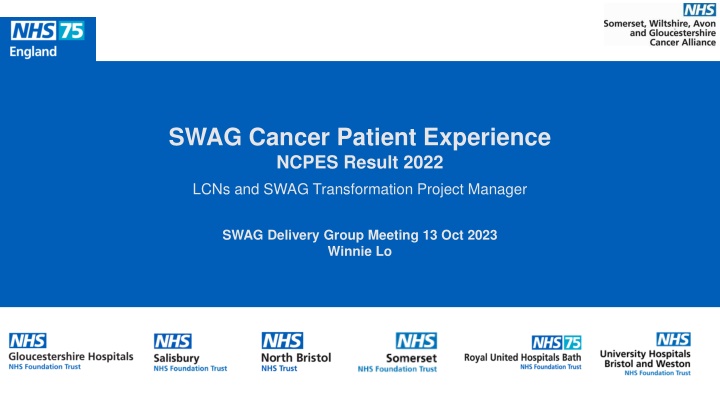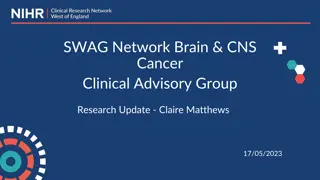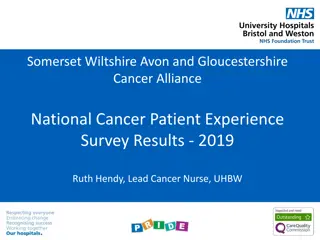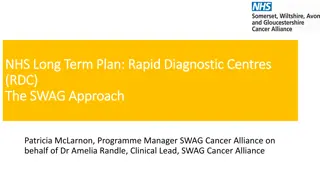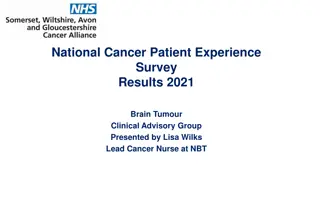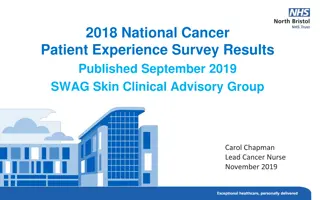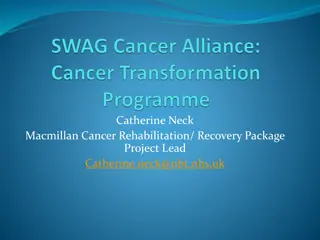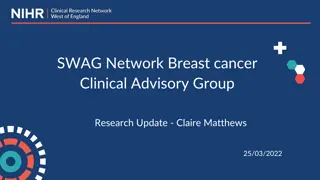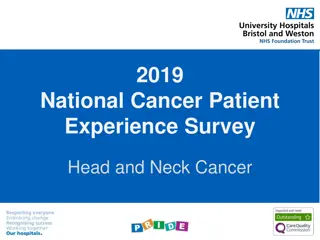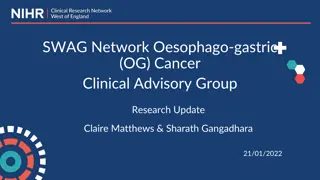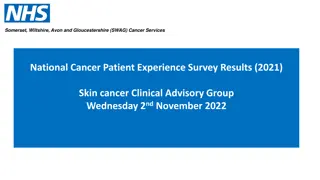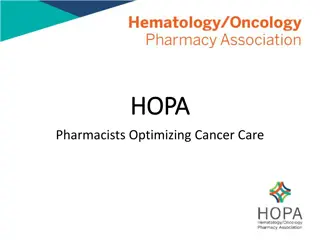SWAG Cancer Patient Experience NCPES Result 2022 - Key Findings
The SWAG Cancer Patient Experience NCPES Result 2022 presents insights from the annual survey conducted to monitor national progress on cancer care experience. It includes methodology details, understanding of the results, and response rates across different trusts.
Download Presentation

Please find below an Image/Link to download the presentation.
The content on the website is provided AS IS for your information and personal use only. It may not be sold, licensed, or shared on other websites without obtaining consent from the author.If you encounter any issues during the download, it is possible that the publisher has removed the file from their server.
You are allowed to download the files provided on this website for personal or commercial use, subject to the condition that they are used lawfully. All files are the property of their respective owners.
The content on the website is provided AS IS for your information and personal use only. It may not be sold, licensed, or shared on other websites without obtaining consent from the author.
E N D
Presentation Transcript
SWAG Cancer Patient Experience NCPES Result 2022 LCNs and SWAG Transformation Project Manager SWAG Delivery Group Meeting 13 Oct 2023 Winnie Lo
NCPES Introduction: Annual survey, 12th iteration of the survey First undertaken in 2010 Commissioned and managed by NHS England Picker is responsible for the technical design, implementation and survey analysis Aim and Objectives: To monitor national progress on experience of cancer care To provide information to drive local quality improvements To assist commissioners and providers of cancer care To inform the work of the various charities and stakeholder groups supporting patients The questionnaire was reviewed in 2021 to reflect changes to cancer services and commitment to cancer care. (NHS Long Term Plan)
Methodology: Mixed methods Who were included? NHS patients with cancer diagnosis All adult (aged 16 or over) Discharged from an NHS trust after an inpatient episode or day case attendance for cancer related treatment Experience of cancer related treatment in the months of April, May and June 2022 Questionnaires: by post, online option or phone (interpreters) Comparability: 2021 and 2022
Understanding the results: Case-mix adjustment: Adjusted scores: understand how an Alliance is performing given their patient population (Factors: gender, age, ethnicity, deprivation, cancer type) Unadjusted data: show the actual patients' responses Case-mix adjusted data and expected ranges: understand whether the results are significantly higher or lower than national results Scoring methodology: 61 questions were scored - directly to patient experience Q59 was scored based rating on a scale of 0 to 10 Suppression rules: Data is suppressed for two reasons: rid of unreliable results based on very small number, preventing individuals from being identifiable.
Results: Response Rate: National: 53% (133 Trusts| 61,268 responses) SWAG: 58% (6 Trusts| 3,417 responses) 59% in 2021 Trusts: Gloucester: 61% North Bristol: 61% Salisbury: 63% Somerset: 64% Royal United Bath: 61% United Hospital Bristol & Weston: 51% 55% in 2021 Mode of response:
Responses by Patient characteristics: Responses by Ethnicity: National SWAG No. of respondents 53,849 1,618 1,009 539 % of No. of respondents 3,135 25 26 17 % of Ethnicity responses 87.9% 2.6% 1.6% 0.9% responses 91.8% 0.7% 0.8% 0.5% White Asian Black Mixed 338 3,915 61,268 0.6% 6.4% 100% 7 0.2% 6% 100% Other Not given Total 184 3,417 Patient Characteristics: By Gender sexual orientation Age IMD quintile Further analysis long term conditions different tumour groups cancer types were reported. By other characteristics
SWAG results: Overall Experience within SWAG: Captured by Q59 using scale 0-10 from very poor to very good. SWAG Cancer Alliance scored at 8.9 (same as the England score) from 9.0 in 2021 Questions Above and Below Expected Range: No question scored below Expected range Q58 showed that SWAG is within the lower of the range. This finding is consistent with last year
SWAG results (cont.): Questions that scored less than previous year: Diagnostic, Care Planning, Hospital Care Questions that scored higher than previous year: Q12 (finding out that you had cancer), Q22 (Deciding on the best treatment), Q52 (Patient has had a review of cancer care by GP practice) The scores in the comparability tables, offered an indication of direction of changes, year on year, provide a signal in areas for continuous improvement and evidence for assurance in progress.
Urology Responses Urology Responses Prostate + other urological Prostate + other urological Individual Trusts responses University Hospitals Bristol and Weston NHS FT 21+23 SWAG Urology overall rating of care = 8.8/10 Gloucestershire Hospitals NHS FT 45+31 Somerset NHS FT 67+23 SWAG overall rating of care = 8.9/10 (national average) Royal United Hospital Bath NHS FT 53+20 Salisbury NHS FT 35+34 North Bristol NHS FT 142+47 Yeovil District NHS FT 24+18 TOTAL: 642
SWAG SWAG Urology Highest Scores > 90% Urology Highest Scores > 90% Prostate SWAG Urology SWAG SWAG Average National Average Question Patient received all the information needed about the diagnostic test in advance 95 92 94 92 5 Enough privacy was always given to the patient when receiving diagnostic test results 96 93 95 95 9 Patient found advice from main contact person was very or quite helpful 95 96 96 95 19 A member of their care team helped the patient create a plan of care to address any needs or concerns 93 96 94 93 25 Care team reviewed the patients care plan with them to ensure it was up to date 97 97 98 99 26 Staff provided the patient with relevant information on available support 94 89 92 90 27 Hospital staff always did everything they could to help the patient to control pain 90 80 86 84 36 Patient was always treated with dignity and respect in hospital 92 87 88 88 37 Beforehand patient had completely enough information about surgery 87 91 90 89 41 Beforehand patient had completely enough information about radiotherapy 92 78 90 88 The whole team worked well together 92 86 90 90 56
SWAG Urology Lowest Scores < 60% SWAG Urology Lowest Scores < 60% Prostae SWAG Urology SWAG SWAG Average National average Question 23 Patient could get further advice or a second opinion before making decisions about their treatment. 51 50 52 50 29 Patient was offered information about how to get financial help/benefits 68 49 74 67 47 Patient felt possible long-term side effects were definitely explained in a way they could understand in advance of their treatment 66 55 60 59 48 Patient was definitely able to discuss options for managing the impact of any long term side effects 55 50 55 53 49 Care team gave family or someone close, all the information needed to help care for the patient at home 57 56 61 58 50 During treatment, the patient definitely got enough care and support at home from community or voluntary services 47 45 53 51 51 Patient definitely received the right amount of support from their GP practice during treatment 56 53 50 45
SWAG Urology Lowest Scores < 60% SWAG Urology Lowest Scores < 60% Prostae SWAG Urology SWAG SWAG Average National average Question 52 Patient has had a review of cancer care by GP practice 24 24 23 21 53 After treatment, the patient definitely could get enough emotional support at home from community or voluntary services 35 39 35 31 58 Cancer research opportunities were discussed with patient 37 26 41 43 4 questions did not score due to lower than 10 responses (immunotherapy)
Suggested themes for Suggested themes for Collaborative working Collaborative working Celebrate what is going well CNS teams and support/advice given (Q19, 41) Team working well together(Q 56) Recognise opportunities for improvement Cancer research opportunities (Q58) Information on side effects and management (Q47, 48) Ability to influence cancer care reviews with EOTS (Q 52)
Next Steps: Share and disseminate NCPES 2022 findings to Board, CAGs, Delivery groups and various forums Continue to develop a SWAG CPES dashboard to enable further data analysis Gain insights into patient experiences at more granular level Highlight areas of challenges associated with health inequalities Identify common themes of challenges and good practices across SWAG, trusts and primary care Agree recommendation for improvement plans and opportunity for collaboration Further embed and expand access to PCS Triangulation with ongoing QoL survey results Consider various strategies for increasing survey uptake for the next NCEPS in 2023
